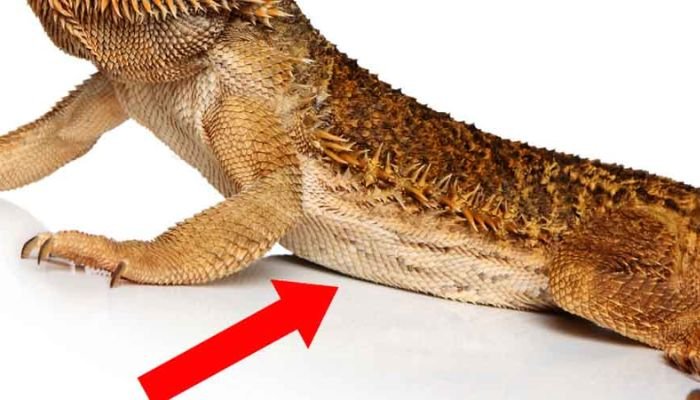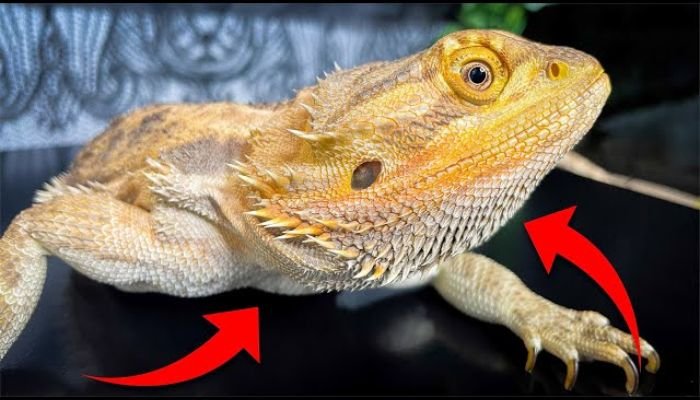Bearded dragons, with their endearing personality and striking good looks, are rapidly rising in popularity as exotic pet options. These reptiles are found naturally in dry areas of Australia, but are frequently kept as pets because of their small size, low maintenance requirements, and interesting personalities. However, much like any other pet, bearded dragons can experience negative effects from stress.
In this all-inclusive book, we’ll delve into the fascinating world of bearded dragon stress marks, investigate the many potential causes of stress in these cherished reptiles, and offer helpful advice for avoiding, minimizing, and dealing with the effects of stress on your pet. We will also talk about when it is absolutely necessary to consult a veterinarian.
Understanding Bearded Dragon Stress Marks
Bearded dragons show stress through the development of stress marks, also called stress lines or bars. Bearded dragons often develop dark, wavy lines on their bellies called stress marks. These scars, which can be anything from dark brown to black, are a sure sign that your pet is in pain.
The Causes of Stress Marks on Bearded Dragons
Bearded dragons’ stress markings can be caused by a number of factors, not all of which are evident to humans. If you care about your pet’s health, you must investigate the reasons of stress and take steps to alleviate them. The following are some of the most typical causes of stress marks:
- Improper Housing Conditions: The bearded dragon may become stressed due to inadequate housing conditions such as inadequate enclosures, inappropriate temperature gradients, or inadequate lighting.
- Handling and Socialization: Bearded dragons are sociable creatures, yet they can experience stress from excessive or inappropriate handling. Stress marks appear as a result of excessive or hard handling.
- Inadequate Diet: Bearded dragons should acquire their nutrition from a variety of insects and vegetables, but most don’t get enough of either. Stress can be brought on by a poor diet or irregular eating routine.

- Inadequate Hydration: Bearded dragons need fresh water available at all times or they will quickly become dehydrated. Stress levels may rise in response to dehydration.
- Territorial Issues: Because of their territorial nature, bearded dragons may become anxious if kept too close to another bearded dragon or an alien species.
- Environmental Changes: Movement to a new cage or the addition of new furnishings may be a stressful event for animals.
- Health Issues: Stress can also be caused by underlying health problems or infections, which can then manifest as visible scarring.
How to Prevent or Mitigate Stress for Your Bearded Dragon
The health and happiness of your bearded dragon depends on your ability to keep stress at bay. Some concrete actions you can take are as follows:
- Provide Proper Enclosure: Bearded dragons require specific environmental conditions to thrive, so it’s important to give your pet a home that has adequate space, ventilation, and temperature variation. For optimal health, they require a basking space equipped with a heat lamp and UVB light source.
- Handle with Care: Reduce the amount of handling you do and make sure it’s always gentle and calm. Never let their full weight fall entirely on their legs.
- Maintain a Healthy Diet: nsects (crickets, mealworms, dubia roaches) and vegetables (collard greens, mustard greens, squash) make up a healthy portion of your bearded dragon’s diet. Vitamin and calcium supplements are also highly recommended.
- Provide Adequate Hydration: Keep Your Bearded Dragon Well-hydrated by offering it new water often in a shallow dish. You can also boost the humidity in their enclosure by misting it softly.
- Minimize Territorial Conflicts: To reduce the likelihood of territorial disputes, separate bearded dragons of different sizes and sexes. Give them some room to breathe.
- Gradual Environmental Changes: Reduce stress by phasing in new elements or modifications to their environment rather than all at once. Watch for any symptoms of distress in their demeanor.
How to Calm a Stressed Bearded Dragon
If your bearded dragon is showing indications of stress, like as stress marks, it is critical that you take steps to alleviate their anxiety. Methods for calming an anxious bearded dragon:
- Provide a Quiet Environment: Make sure there isn’t much background noise or disruption in the area around their cage.
- Limit Handling: Avoid handling your bearded dragon too much until you see signs of calmness.
- Offer Their Favorite Foods: Give them what they like, such as insects or snacks, to get them to eat and let them relax.
- Create a Hideaway: Give them a place to go in their enclosure where they can hide if they start to feel unsafe.
- Maintain Consistent Care: Providing a sense of stability can be accomplished through maintaining a consistent feeding and lighting schedule.
- Observe for Improvement: In order to better care for your bearded dragon, you should observe it frequently. The hope is that as stress levels drop, the marks will gradually be erased.
When to Call a Vet About Your Stressed Bearded Dragon
Bearded dragons may usually recover from stress with some TLC and a change in scenery, but there are times when a vet visit is in order. Here are some warnings that it’s time to call in a reptile vet:
- If stress marks continue to appear or worsen despite your best attempts to manage your stress, you may want to see a doctor.
- When your bearded dragon suddenly stops eating, it could be a symptom of disease or extreme stress.
- A bearded dragon that is lethargic on a regular basis and doesn’t react to attempts to stimulate it may need veterinary care.
- Respiratory Distress: Signs of respiratory distress include labored breathing, wheezing, or audible clicking sounds during breathing.
- Discoloration, swelling, or sores on the skin or scales are all signs that veterinary attention is needed.
- Regurgitation of food or a frothy substance occurs frequently, which may be a sign of digestive issues.
Facts
[table id=31 /]
Conclusion
A Summary of Bearded Dragon Stress Marks
Bearded dragon ownership is enjoyable, but it also comes with the duty of looking out for the animal’s health and happiness. It is vital to the well-being of these reptiles that we learn how to identify and alleviate their stress.
You can make life in captivity much more pleasant for your bearded dragon by understanding what stresses it out, taking steps to mitigate those causes, and knowing when to see an expert for assistance. Keep in mind that the time and care you put into your bearded dragon will pay off in spades when they reach adulthood. In this article, we have explored “Bearded Dragon Stress Marks.” I hope you like it.

